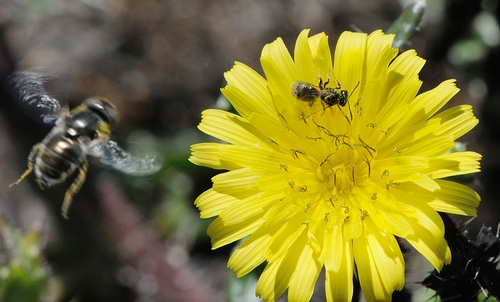- Author: Kathy Keatley Garvey
If you've ever been to Bodega Head in Sonoma County, you may have marveled at the waves crashing and the whales surfacing.
But have you ever seen the digger bees, Anthophora bomboides stanfordiana, aka bumble bee mimics, that nest in the sandstone cliffs?
They're there. They're foraging on flowers, excavating their nests, and rearing young.
These digger bees are not easy to photograph. On our May 9th trip, we got lucky: our 200mm macro lens picked up a digger bee warming its flight muscles.
"The species name indicates that it is a bumble bee mimic," the late Robbin Thorp (1933-2019), a global authority on bumble bees and a UC Davis distinguished emeritus professor of entomology. "These bees need a source of fresh water nearby. Females suck up water, regurgitate it on the sandstone bank surface, then dig away at the soft mud. They use some of the mud to build entrance turrets, presumably to help them locate their nests within the aggregation of nests."
"The female," Thorp said, "sucks up fresh water from nearby, stores it in her crop (like honey bees store nectar) for transport to the nest. She regurgitates it on the sandstone, and excavates the moistened soil. She carries out the mud and makes the entrance turret with it."
Thorp, a 30-year member of the Department of Entomology and Nematology, studied these bees. (See his presentation at the Proceedings of the Symposium on Biodiversity of Northwestern California, Santa Rosa, delivered in October 1991.)
Today, community ecologist and associate professor Rachel Vannette from the same department, is among scientists engaged in the research of these fascinating bees.
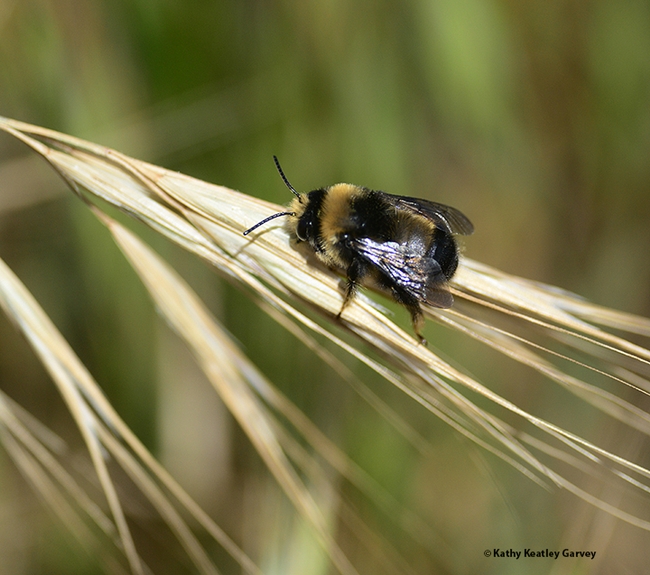
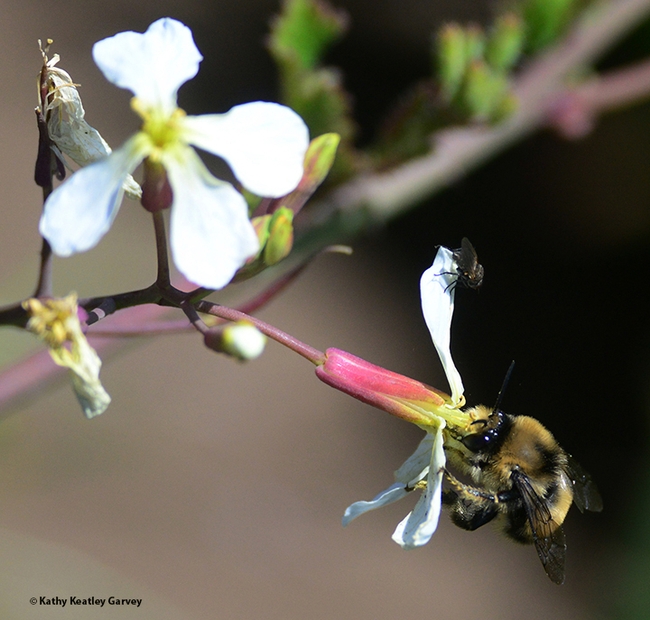
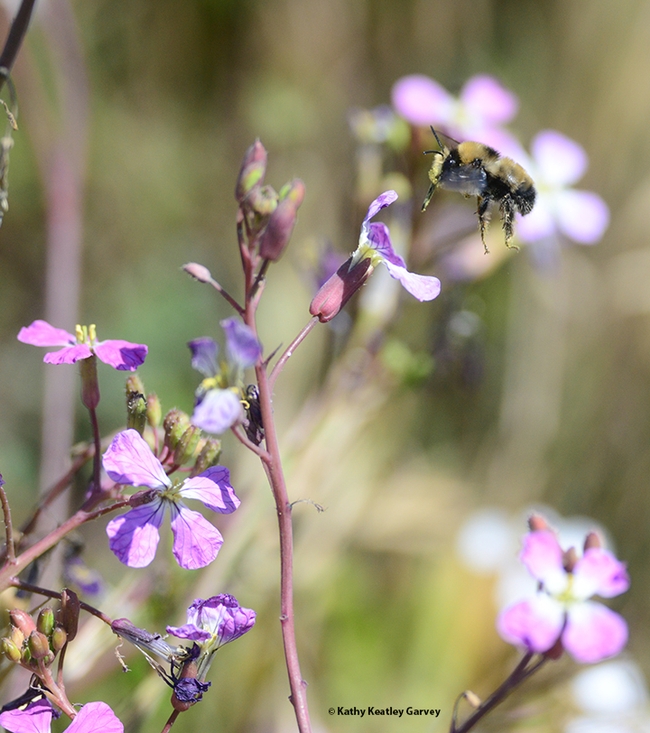
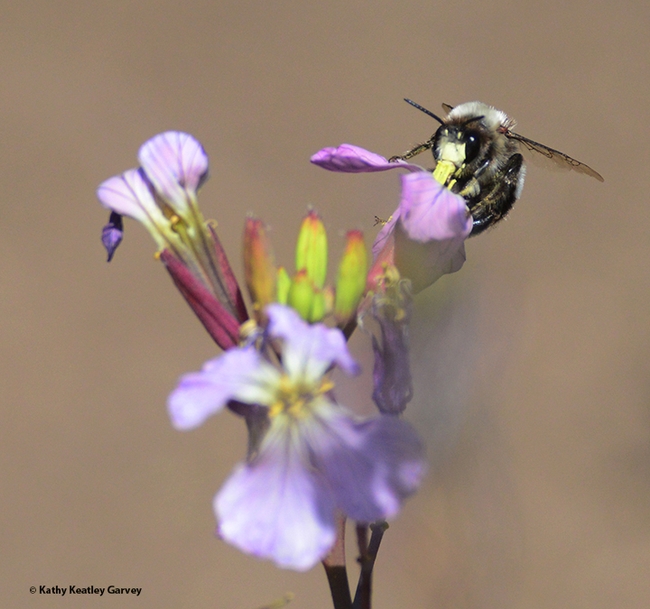
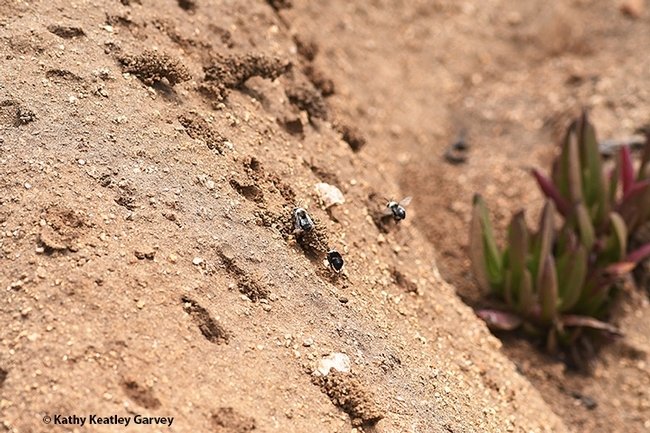
- Author: Kathy Keatley Garvey
There's more to Sonoma County's Bodega Head than the stunning views, crashing waves, nesting seabirds, and bursts of flora and fauna.
The sand cliffs are also the home of a digger bee, a bumble bee mimic known as Anthophora bomboides stanfordiana.
"The species name indicates that it is a bumble bee mimic," the late Robbin Thorp, a global authority on bumble bees and a UC Davis distinguished emeritus professor of entomology, told us several years ago. "These bees need a source of fresh water nearby. Females suck up water, regurgitate it on the sandstone bank surface, then dig away at the soft mud. They use some of the mud to build entrance turrets, presumably to help them locate their nests within the aggregation of nests."
"The female," Thorp said, "sucks up fresh water from nearby, stores it in her crop (like honey bees store nectar) for transport to the nest. She regurgitates it on the sandstone, and excavates the moistened soil. She carries out the mud and makes the entrance turret with it."
On multiple trips to Bodega Bay over the years, we watch in fascination as the bees excavate their homes, zip in and out of their turrets, and nectar on nearby flowers.
This time (June 24) we photographed an ant and bee encounter on a turret. The ant? Formica transmontanis, according to ant specialists Phil Ward, professor of entomology at UC Davis, and UC Davis alumnus Brendon Boudinot, who recently received his doctorate from UC Davis, studying with Ward.
"The species nests on the bluffs," Ward told us.
And about that bee-ant encounter? Commented Boudinot: "I suspect the little lady was alarmed by the big bee. These ants and their relatives are rather passive scavengers except during the brooding season, when fresh meat is an order. Most entomeat for Formica tend to be free-walking insects than barricaded larvae, as probably for the bee. For these reasons I think that the encounter may be coincidental!"
Scores of UC Davis entomologists have engaged in research at Bodega Bay. Rachel Vannette, assistant professor, UC Davis Department of Entomology and Nematology, is currently researching Anthophora bomboides stanfordiana and its nests as part of a National Science Foundation grant. Her project on solitary bee provision microbiome includes investigating the diverse community of bacteria and fungi in the provisions and brood cells.
While COVID-19 mandates and precautions hamper her research team's efforts (she's done some preliminary sampling this year and the entire team is planning to do research next year), the digger bees of Bodega Head keep digging, crafting turrets, nectaring on the nearby flora--and encountering ants.
They're all in this together.
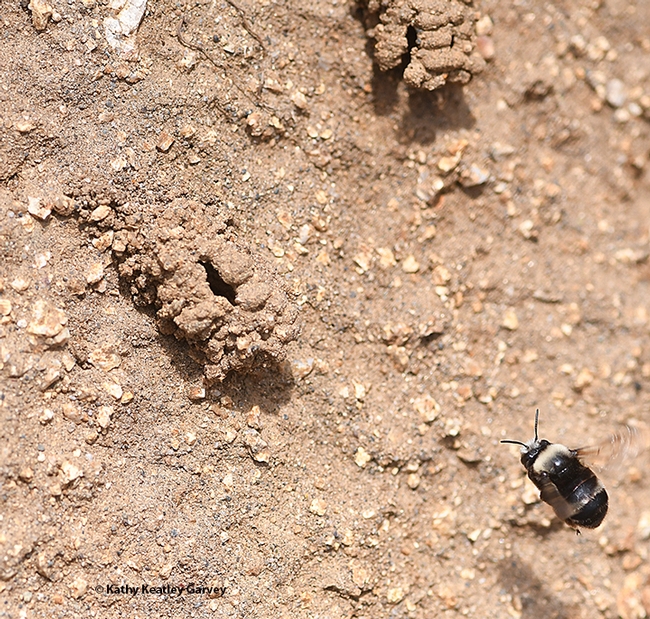
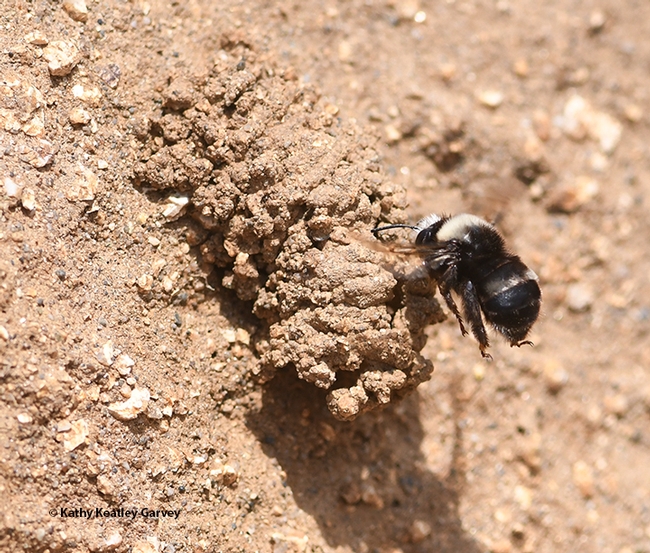
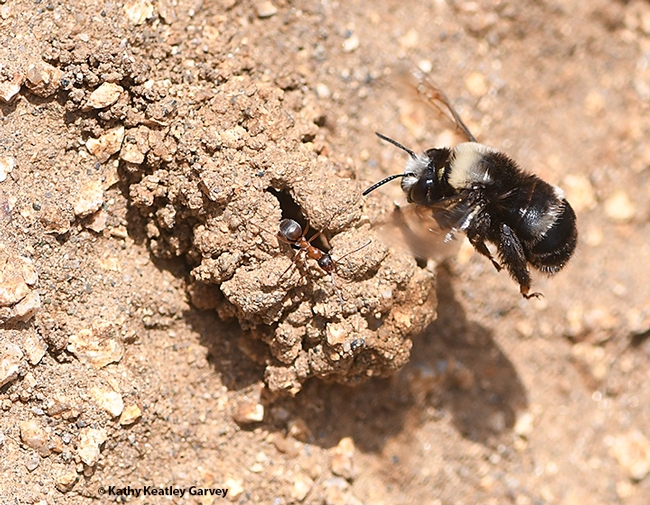
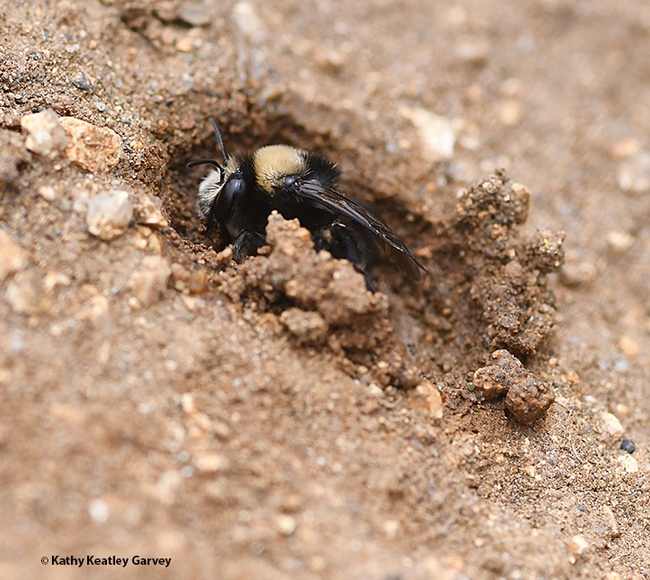
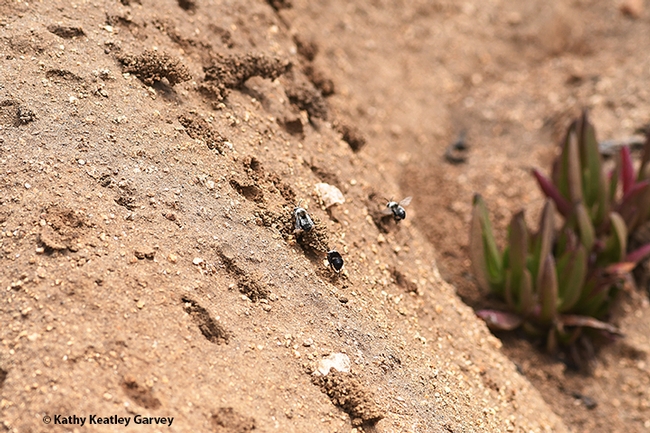
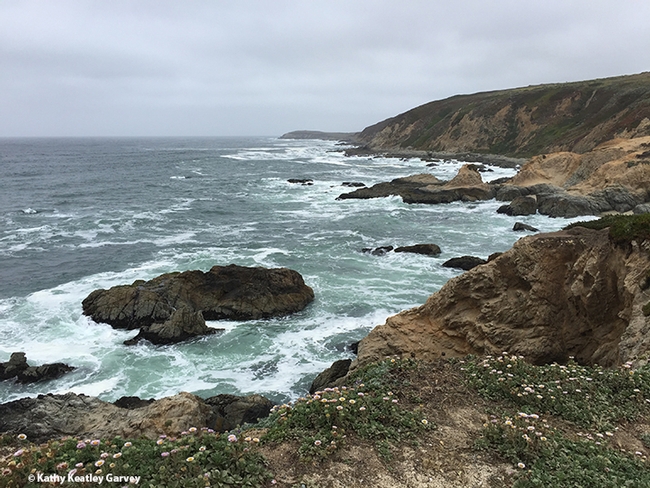
- Author: Kathy Keatley Garvey
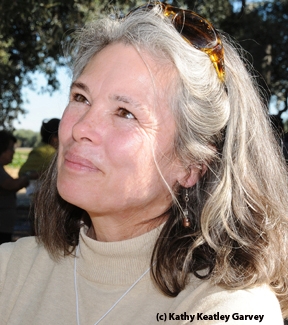
This would include mustards, clover and buckwheat, plants that honey bees love.
Kellison, the executive director of the Santa Rosa-based Partners for Sustainable Pollination, will speak Thursday, Aug. 8 at the 13th annual Sustainable Winegrowing Field Day, to be held at the Shone Farm at 7350 Steve Olson Lane, Forestville.
The field day is sponsored by the Sonoma County Winegrowers, Santa Rosa Junior College Agriculture/Natural Resources Department and the California Sustainable Winegrowing Alliance.
There is no cost to attend but pre-registration (online only) is required by Aug. 2. The event begins with registration at 7:30 a.m. and concludes with a courtesy lunch. (Agenda is online.)
Kellison, to speak at 11:30 a.m., will cover bee-friendly farming, agricultural practices to improve bee health, and why it’s important to plant bee friendly landscapes, including bee gardens. "One major factor in the decline of all bees is the lack of food plants," she says.
Wine growers and beekeepers can work together to make better bee nutrition a reality, Kellison says.
Natural forage and nutrition are essential to good honey bee health and to their ability to cope with pests, pathogens and other stressors, she points out. "Special consideration must be given to encouraging plantings of late summer and fall blooming plants to help hives survive through the winter to the next blooming season."
Among the half-dozen speakers at the field day will be Doug Gubler of UC Davis, who will discuss “Fungicide Resistance Management and Prevention for Grapevine Diseases." Lucia Varela, UC Cooperative Extension pest advisor, will provide a display on how to identify the adult Virginia creeper leafhopper.
Partners for Sustainable Pollination (PSP), founded in 2007, aims to work with farmers and beekeepers to improve the health of honey bees and support native pollinators. "We foster awareness and support for providing increased availability of flowering plants to honey bees and native pollinators," Kellison says.
Partners include local conservation districts, growers, beekeeping and farm groups, and other stakeholders.
One of the PSP advisors is Extension apiculturist Eric Mussen of the UC Davis Department of Entomology and Nematology.
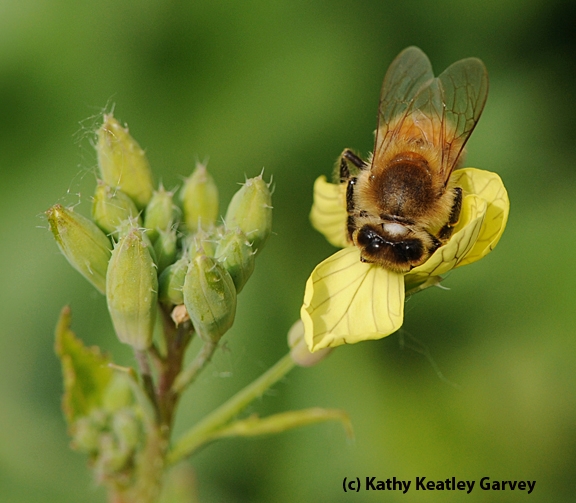

- Author: Kathy Keatley Garvey
Squatters' rights.
A dandelion poking through the rocks near Nick's Cove on Tomales Bay, in Marshall, Sonoma County, seemed an unlikely host for squatters' rights.
It first drew a tiny bee, barely a quarter-inch long. It was a female sweat bee, family Halictidae, genus Lasioglossum, subgenus Dialictus.
She claimed the dandelion all to herself.
Not for long.
Another insect shadowed the dandelion and swooped down to feed.
It was a hover fly, family Syrphidae. (Probably a Eristalinus aeneus, observed UC Davis pollinator specialist Robbin Thorp, emeritus professor of entomology at UC Davis.)
So on one dandelion: a fly and a bee.
The fly is bigger. But the bee can sting. The sting, however, is rated only 1.0 on the Schmidt Sting Pain Index compiled by (now retired) entomologist Justin O. Schmidt at the Carl Hayden Bee Research Center, Tucson, Ariz.
Fight or flight?
Flight.
The dandelion blossom belongs to the fly.
